Supply Chain Management Report: Technology, Risks and Future Trends
VerifiedAdded on 2022/09/07
|5
|1060
|32
Report
AI Summary
This report provides an analysis of two reports focused on supply chain management. The first report discusses the use of blockchain technology, Internet of Things, AI, and CRM in supply chains, highlighting benefits like improved tracking and disruption management. It also mentions the risks associated with AI. The second report examines the gap between current and future technologies, including ERP systems, automation tools, and digital supply chains, while also addressing the limitations of blockchain technology and digital supply chains. The analysis provides feedback on the conclusions of each report, noting the persuasiveness of the information presented and emphasizing the importance of technology in supply chain management for decision-making. The report also mentions the limitations of the technologies mentioned in the reports.
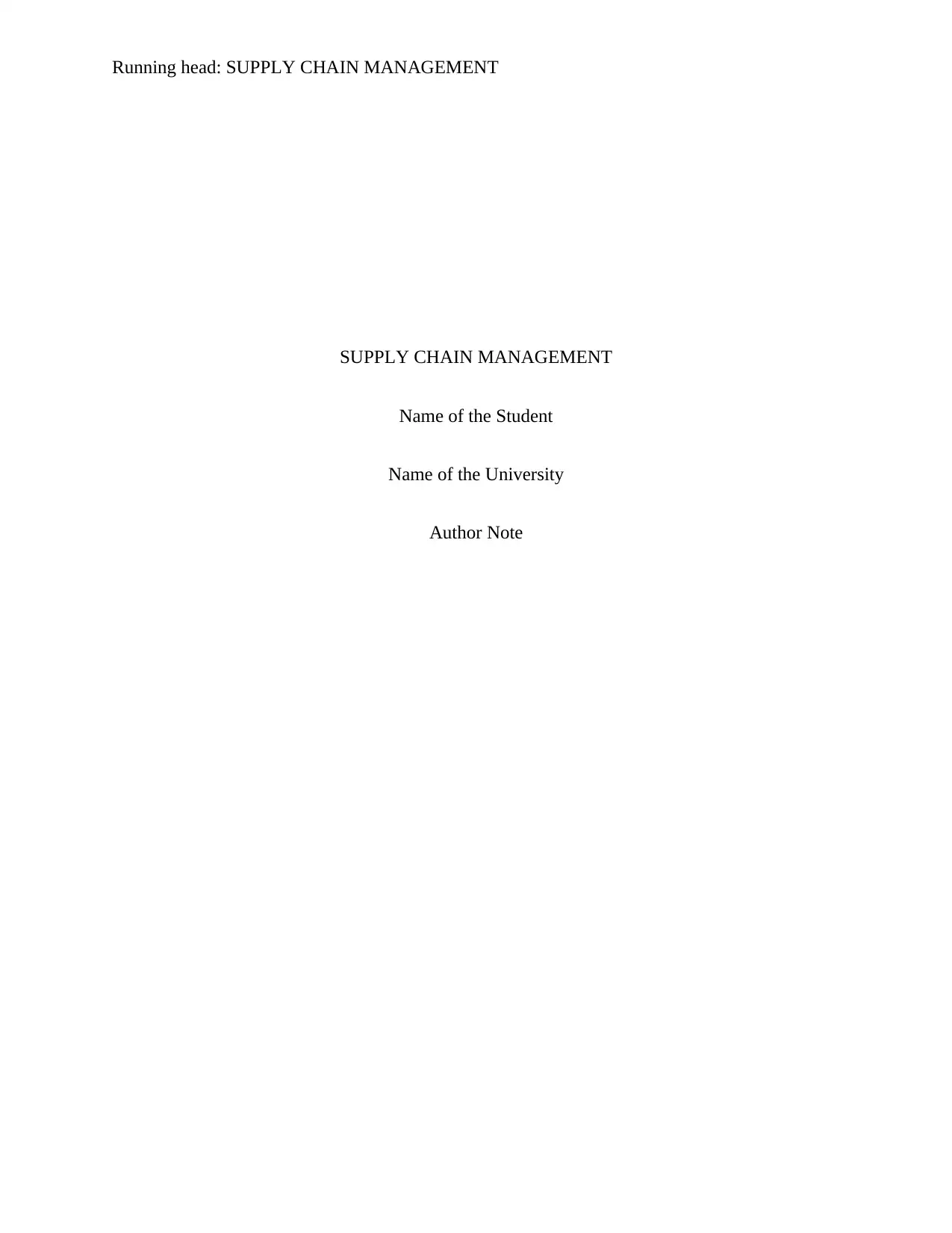
Running head: SUPPLY CHAIN MANAGEMENT
SUPPLY CHAIN MANAGEMENT
Name of the Student
Name of the University
Author Note
SUPPLY CHAIN MANAGEMENT
Name of the Student
Name of the University
Author Note
Paraphrase This Document
Need a fresh take? Get an instant paraphrase of this document with our AI Paraphraser
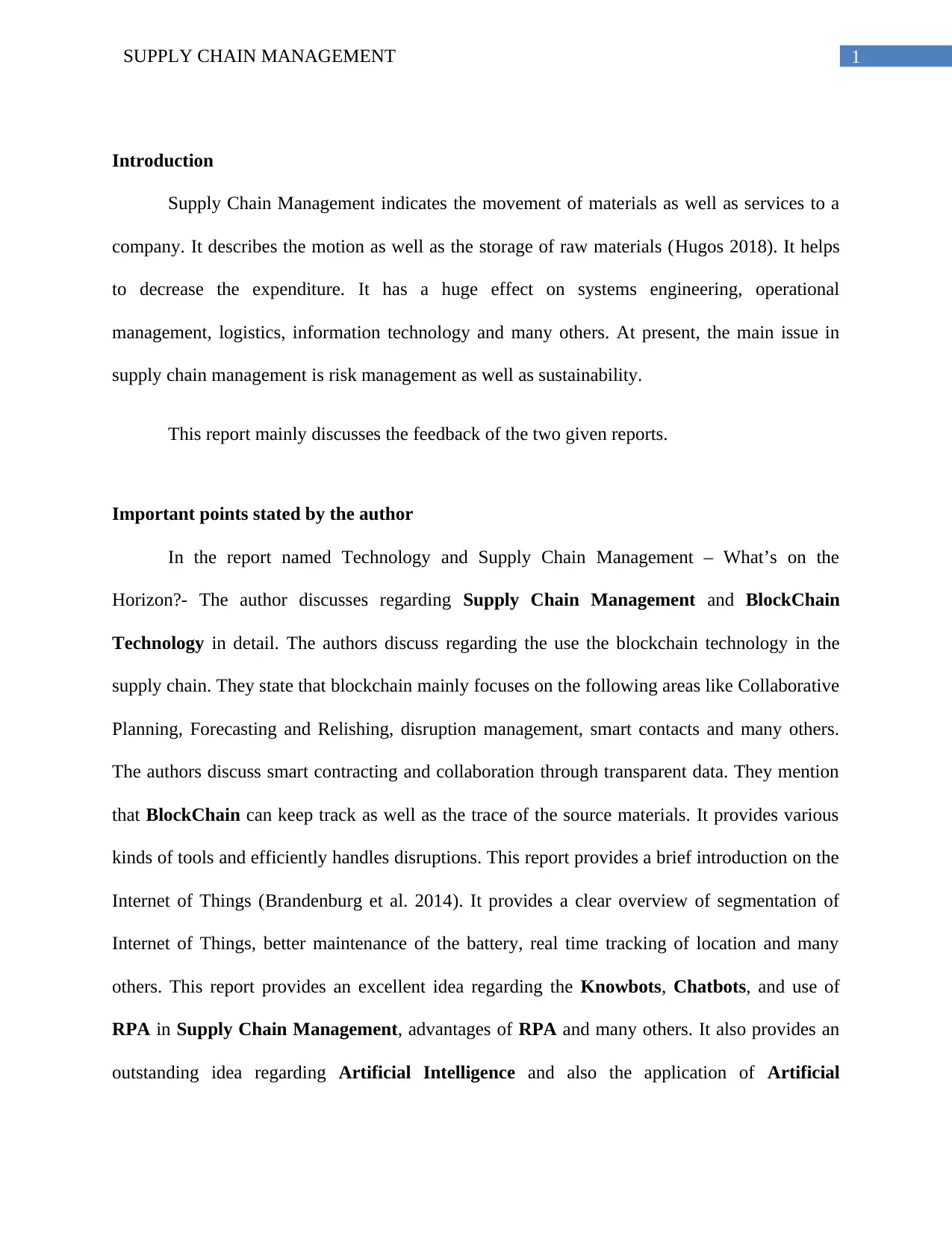
1SUPPLY CHAIN MANAGEMENT
Introduction
Supply Chain Management indicates the movement of materials as well as services to a
company. It describes the motion as well as the storage of raw materials (Hugos 2018). It helps
to decrease the expenditure. It has a huge effect on systems engineering, operational
management, logistics, information technology and many others. At present, the main issue in
supply chain management is risk management as well as sustainability.
This report mainly discusses the feedback of the two given reports.
Important points stated by the author
In the report named Technology and Supply Chain Management – What’s on the
Horizon?- The author discusses regarding Supply Chain Management and BlockChain
Technology in detail. The authors discuss regarding the use the blockchain technology in the
supply chain. They state that blockchain mainly focuses on the following areas like Collaborative
Planning, Forecasting and Relishing, disruption management, smart contacts and many others.
The authors discuss smart contracting and collaboration through transparent data. They mention
that BlockChain can keep track as well as the trace of the source materials. It provides various
kinds of tools and efficiently handles disruptions. This report provides a brief introduction on the
Internet of Things (Brandenburg et al. 2014). It provides a clear overview of segmentation of
Internet of Things, better maintenance of the battery, real time tracking of location and many
others. This report provides an excellent idea regarding the Knowbots, Chatbots, and use of
RPA in Supply Chain Management, advantages of RPA and many others. It also provides an
outstanding idea regarding Artificial Intelligence and also the application of Artificial
Introduction
Supply Chain Management indicates the movement of materials as well as services to a
company. It describes the motion as well as the storage of raw materials (Hugos 2018). It helps
to decrease the expenditure. It has a huge effect on systems engineering, operational
management, logistics, information technology and many others. At present, the main issue in
supply chain management is risk management as well as sustainability.
This report mainly discusses the feedback of the two given reports.
Important points stated by the author
In the report named Technology and Supply Chain Management – What’s on the
Horizon?- The author discusses regarding Supply Chain Management and BlockChain
Technology in detail. The authors discuss regarding the use the blockchain technology in the
supply chain. They state that blockchain mainly focuses on the following areas like Collaborative
Planning, Forecasting and Relishing, disruption management, smart contacts and many others.
The authors discuss smart contracting and collaboration through transparent data. They mention
that BlockChain can keep track as well as the trace of the source materials. It provides various
kinds of tools and efficiently handles disruptions. This report provides a brief introduction on the
Internet of Things (Brandenburg et al. 2014). It provides a clear overview of segmentation of
Internet of Things, better maintenance of the battery, real time tracking of location and many
others. This report provides an excellent idea regarding the Knowbots, Chatbots, and use of
RPA in Supply Chain Management, advantages of RPA and many others. It also provides an
outstanding idea regarding Artificial Intelligence and also the application of Artificial
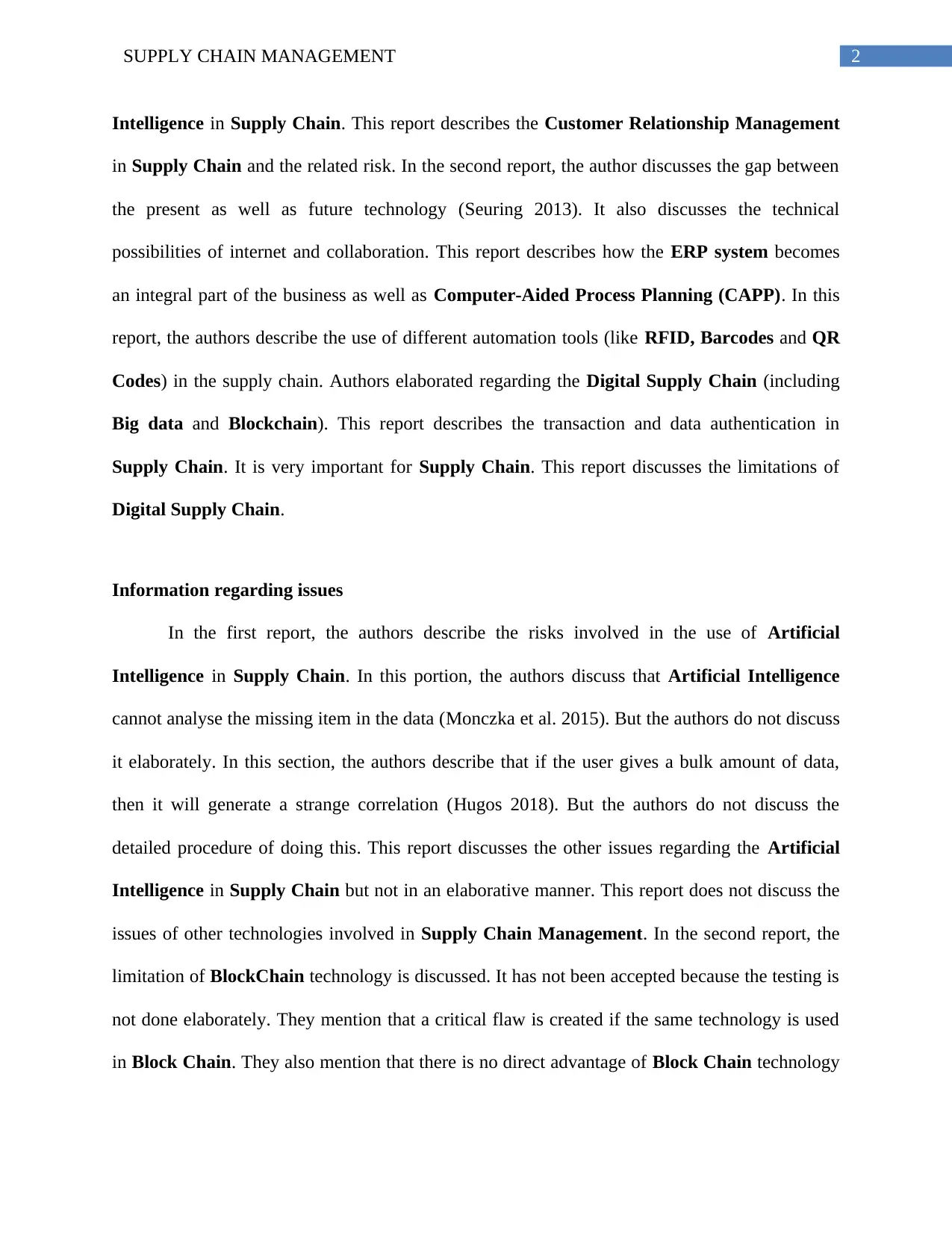
2SUPPLY CHAIN MANAGEMENT
Intelligence in Supply Chain. This report describes the Customer Relationship Management
in Supply Chain and the related risk. In the second report, the author discusses the gap between
the present as well as future technology (Seuring 2013). It also discusses the technical
possibilities of internet and collaboration. This report describes how the ERP system becomes
an integral part of the business as well as Computer-Aided Process Planning (CAPP). In this
report, the authors describe the use of different automation tools (like RFID, Barcodes and QR
Codes) in the supply chain. Authors elaborated regarding the Digital Supply Chain (including
Big data and Blockchain). This report describes the transaction and data authentication in
Supply Chain. It is very important for Supply Chain. This report discusses the limitations of
Digital Supply Chain.
Information regarding issues
In the first report, the authors describe the risks involved in the use of Artificial
Intelligence in Supply Chain. In this portion, the authors discuss that Artificial Intelligence
cannot analyse the missing item in the data (Monczka et al. 2015). But the authors do not discuss
it elaborately. In this section, the authors describe that if the user gives a bulk amount of data,
then it will generate a strange correlation (Hugos 2018). But the authors do not discuss the
detailed procedure of doing this. This report discusses the other issues regarding the Artificial
Intelligence in Supply Chain but not in an elaborative manner. This report does not discuss the
issues of other technologies involved in Supply Chain Management. In the second report, the
limitation of BlockChain technology is discussed. It has not been accepted because the testing is
not done elaborately. They mention that a critical flaw is created if the same technology is used
in Block Chain. They also mention that there is no direct advantage of Block Chain technology
Intelligence in Supply Chain. This report describes the Customer Relationship Management
in Supply Chain and the related risk. In the second report, the author discusses the gap between
the present as well as future technology (Seuring 2013). It also discusses the technical
possibilities of internet and collaboration. This report describes how the ERP system becomes
an integral part of the business as well as Computer-Aided Process Planning (CAPP). In this
report, the authors describe the use of different automation tools (like RFID, Barcodes and QR
Codes) in the supply chain. Authors elaborated regarding the Digital Supply Chain (including
Big data and Blockchain). This report describes the transaction and data authentication in
Supply Chain. It is very important for Supply Chain. This report discusses the limitations of
Digital Supply Chain.
Information regarding issues
In the first report, the authors describe the risks involved in the use of Artificial
Intelligence in Supply Chain. In this portion, the authors discuss that Artificial Intelligence
cannot analyse the missing item in the data (Monczka et al. 2015). But the authors do not discuss
it elaborately. In this section, the authors describe that if the user gives a bulk amount of data,
then it will generate a strange correlation (Hugos 2018). But the authors do not discuss the
detailed procedure of doing this. This report discusses the other issues regarding the Artificial
Intelligence in Supply Chain but not in an elaborative manner. This report does not discuss the
issues of other technologies involved in Supply Chain Management. In the second report, the
limitation of BlockChain technology is discussed. It has not been accepted because the testing is
not done elaborately. They mention that a critical flaw is created if the same technology is used
in Block Chain. They also mention that there is no direct advantage of Block Chain technology
⊘ This is a preview!⊘
Do you want full access?
Subscribe today to unlock all pages.

Trusted by 1+ million students worldwide
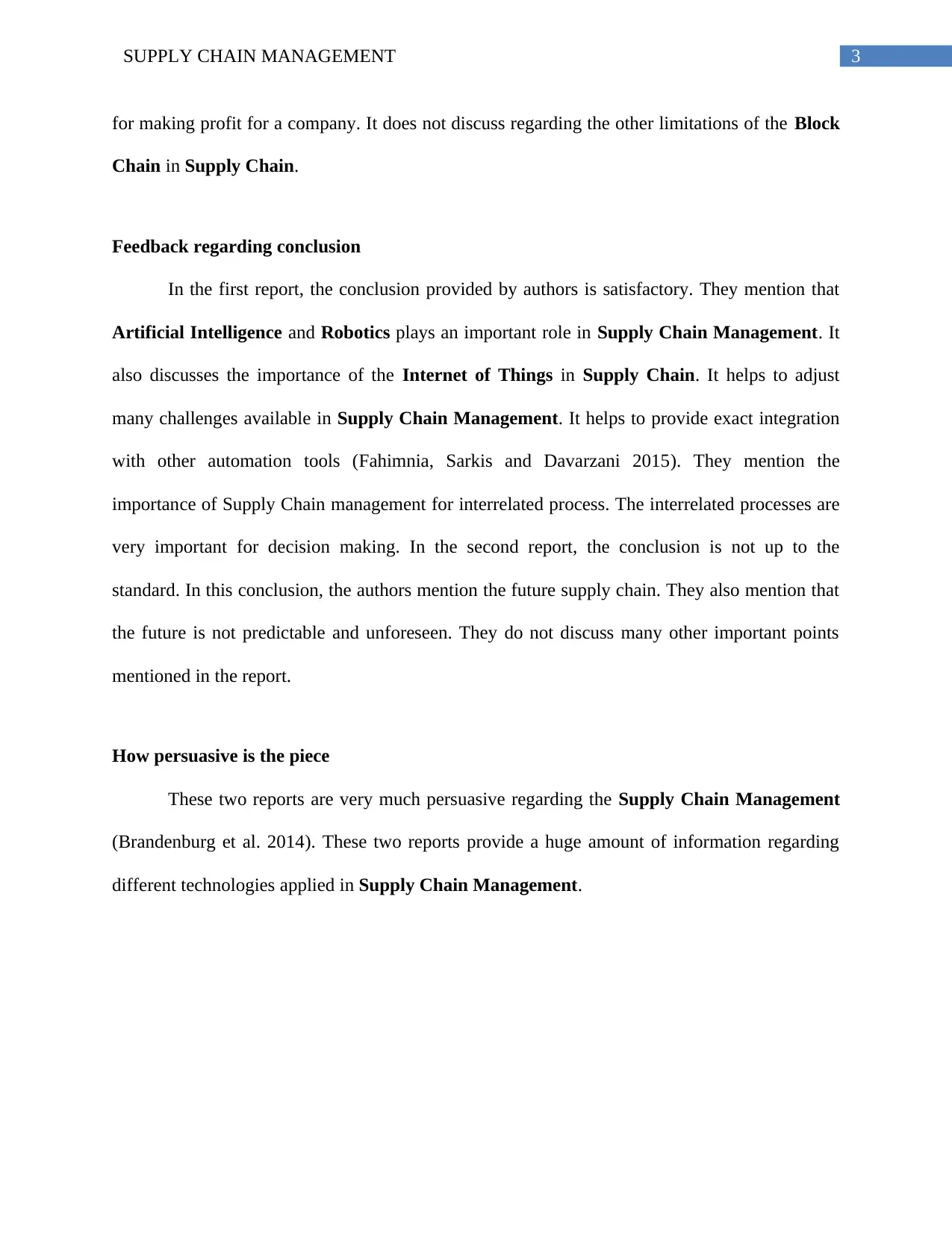
3SUPPLY CHAIN MANAGEMENT
for making profit for a company. It does not discuss regarding the other limitations of the Block
Chain in Supply Chain.
Feedback regarding conclusion
In the first report, the conclusion provided by authors is satisfactory. They mention that
Artificial Intelligence and Robotics plays an important role in Supply Chain Management. It
also discusses the importance of the Internet of Things in Supply Chain. It helps to adjust
many challenges available in Supply Chain Management. It helps to provide exact integration
with other automation tools (Fahimnia, Sarkis and Davarzani 2015). They mention the
importance of Supply Chain management for interrelated process. The interrelated processes are
very important for decision making. In the second report, the conclusion is not up to the
standard. In this conclusion, the authors mention the future supply chain. They also mention that
the future is not predictable and unforeseen. They do not discuss many other important points
mentioned in the report.
How persuasive is the piece
These two reports are very much persuasive regarding the Supply Chain Management
(Brandenburg et al. 2014). These two reports provide a huge amount of information regarding
different technologies applied in Supply Chain Management.
for making profit for a company. It does not discuss regarding the other limitations of the Block
Chain in Supply Chain.
Feedback regarding conclusion
In the first report, the conclusion provided by authors is satisfactory. They mention that
Artificial Intelligence and Robotics plays an important role in Supply Chain Management. It
also discusses the importance of the Internet of Things in Supply Chain. It helps to adjust
many challenges available in Supply Chain Management. It helps to provide exact integration
with other automation tools (Fahimnia, Sarkis and Davarzani 2015). They mention the
importance of Supply Chain management for interrelated process. The interrelated processes are
very important for decision making. In the second report, the conclusion is not up to the
standard. In this conclusion, the authors mention the future supply chain. They also mention that
the future is not predictable and unforeseen. They do not discuss many other important points
mentioned in the report.
How persuasive is the piece
These two reports are very much persuasive regarding the Supply Chain Management
(Brandenburg et al. 2014). These two reports provide a huge amount of information regarding
different technologies applied in Supply Chain Management.
Paraphrase This Document
Need a fresh take? Get an instant paraphrase of this document with our AI Paraphraser
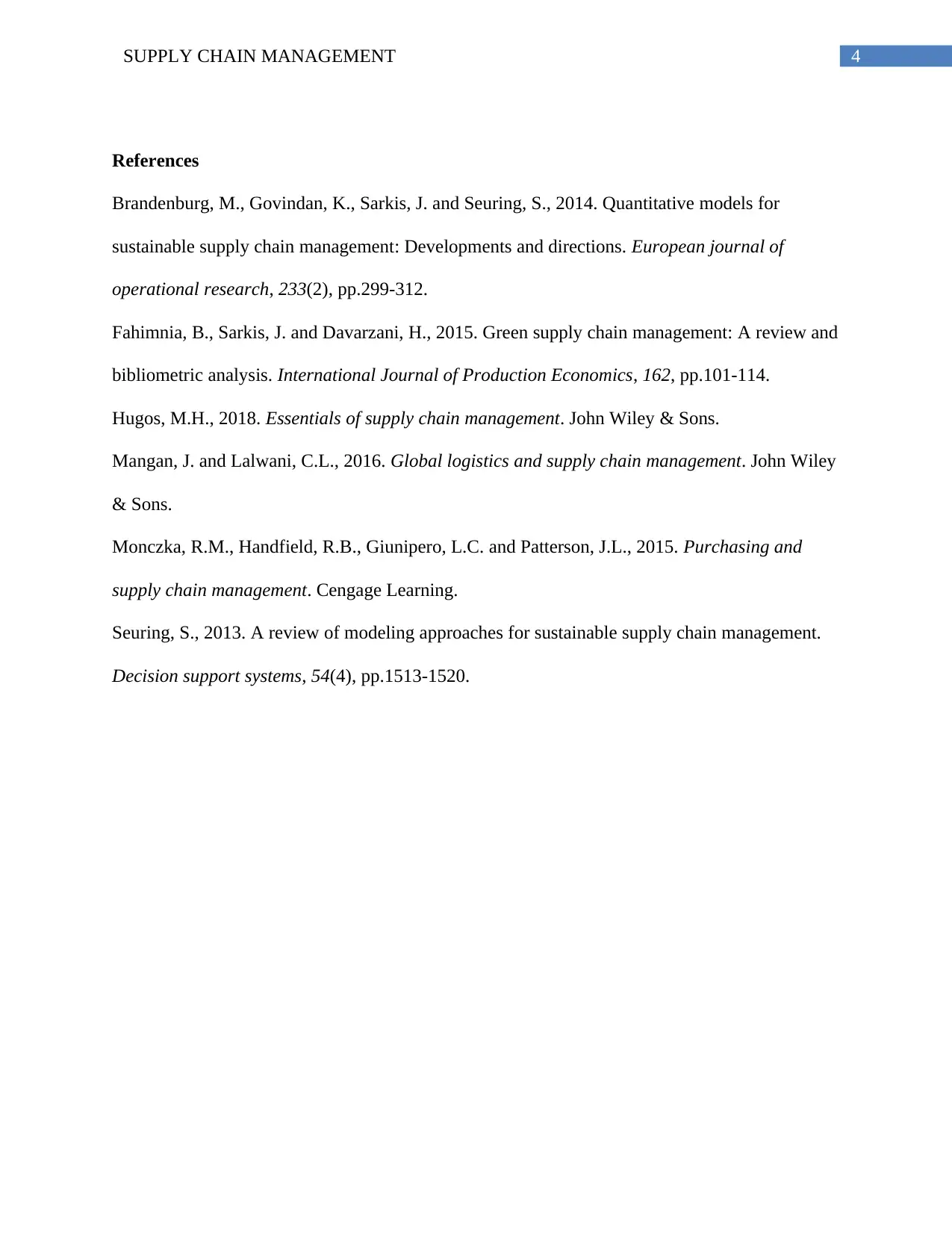
4SUPPLY CHAIN MANAGEMENT
References
Brandenburg, M., Govindan, K., Sarkis, J. and Seuring, S., 2014. Quantitative models for
sustainable supply chain management: Developments and directions. European journal of
operational research, 233(2), pp.299-312.
Fahimnia, B., Sarkis, J. and Davarzani, H., 2015. Green supply chain management: A review and
bibliometric analysis. International Journal of Production Economics, 162, pp.101-114.
Hugos, M.H., 2018. Essentials of supply chain management. John Wiley & Sons.
Mangan, J. and Lalwani, C.L., 2016. Global logistics and supply chain management. John Wiley
& Sons.
Monczka, R.M., Handfield, R.B., Giunipero, L.C. and Patterson, J.L., 2015. Purchasing and
supply chain management. Cengage Learning.
Seuring, S., 2013. A review of modeling approaches for sustainable supply chain management.
Decision support systems, 54(4), pp.1513-1520.
References
Brandenburg, M., Govindan, K., Sarkis, J. and Seuring, S., 2014. Quantitative models for
sustainable supply chain management: Developments and directions. European journal of
operational research, 233(2), pp.299-312.
Fahimnia, B., Sarkis, J. and Davarzani, H., 2015. Green supply chain management: A review and
bibliometric analysis. International Journal of Production Economics, 162, pp.101-114.
Hugos, M.H., 2018. Essentials of supply chain management. John Wiley & Sons.
Mangan, J. and Lalwani, C.L., 2016. Global logistics and supply chain management. John Wiley
& Sons.
Monczka, R.M., Handfield, R.B., Giunipero, L.C. and Patterson, J.L., 2015. Purchasing and
supply chain management. Cengage Learning.
Seuring, S., 2013. A review of modeling approaches for sustainable supply chain management.
Decision support systems, 54(4), pp.1513-1520.
1 out of 5
Related Documents
Your All-in-One AI-Powered Toolkit for Academic Success.
+13062052269
info@desklib.com
Available 24*7 on WhatsApp / Email
![[object Object]](/_next/static/media/star-bottom.7253800d.svg)
Unlock your academic potential
Copyright © 2020–2025 A2Z Services. All Rights Reserved. Developed and managed by ZUCOL.




